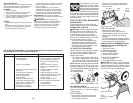
20
Loss of power 1. Rear of lawn mower 1. Raise cutting height.
housing or cutting blade
dragging in heavy grass.
2. Cutting too much grass. 2. Raise cutting height.
3. Dirty air fi lter. 3. Clean/replace air fi lter.
4. Buildup of grass, leaves, 4. Clean underside of mower
and trash under mower. housing.
5. Too much oil in engine. 5. Check oil level.
6. Walking speed too fast. 6. Cut at slower walking speed.
Poor cut – 1. Worn, bent or loose blade. 1. Replace blade. Tighten
uneven blade bolt.
2. Wheel heights uneven. 2. Set all wheels at same
height.
3. Buildup of grass, leaves 3. Clean underside of
and trash under mower. mower housing.
Excessive 1. Worn, bent or loose blade. 1. Replace blade. Tighten
vibration blade bolt.
2. Bent engine crankshaft. 2. Contact a Husqvarna or
other qualifi ed service center.
Starter rope 1. Engine fl ywheel brake is on 1. Depress control bar to
hard to pull when control bar is released. upper handle before
pulling starter rope.
2. Bent engine crankshaft. 2. Contact a Husqvarna or
other qualifi ed service center.
3. Blade adapter broken. 3. Replace blade adapter.
4. Blade dragging in grass. 4. Move lawn mower to cut
grass or to hard surface.
Grass catcher 1. Cutting height too low. 1. Raise cutting height.
not fi lling 2. Lift on blade worn off. 2. Replace blade.
(If so equipped) 3. Catcher not venting air. 3. Clean grass catcher.
Hard to push 1. Grass is too high or wheel 1. Raise cutting height.
height is too low.
2. Rear of lawn mower 2. Raise rear of lawn mower
housing or cutting blade housing one (1) setting
dragging in grass. higher.
3. Grass catcher too full. 3. Empty grass catcher.
4. Handle height position not 4. Adjust handle height to suit.
right for you.
PROBLEM CAUSE CORRECTION
TROUBLESHOOTING - See appropriate section in manual unless directed
to a Husqvarna or other qualifi ed Service Center.
29
OPERACIÓN
FAMILIARICESE CON SU SEGADORA
LEA ESTE MANUAL DEL DUENO Y LAS REGLAS DE SEGURIDAD ANTES DE OPARAR SU
SEGADORA. Compare las ilustraciones con su segadora para familiarizarse con la ubicación de
los diversos controles y ajustes. Guarde este manual para referencia en el futuro.
Estos símbolos pueden apareser sobre su segadora o en la literatura proporcionada con el
producto. Aprenda y comprenda sus signifi cados.
Barra de control que exige
la presencia del operador
Caja
Manilla del mango
Tapa del deposito
de la gasolina
CUMPLE CON LOS REQUISITOS DE SEGURIDAD DE LA CPSC
Las segadoras a motor, que se conducen desde la parte de atrás, rotatorias, Sears, cumplen con los
estándares de seguridad del American National Standards Institute y de la U.S. Con sum er Product
Safety Commission. ADVERTENCIA: La cuchilla gira cuando el motor está funcionando.
Barra de control que exige la presencia del
operador – tiene que sujetarse abajo, junto
con el mango, para hacer arrancar el motor.
Suéltela para parar el motor.
Filtro de aire
Cordón arrancador – se usa para hacer ar-
rancar el motor.
Puerta de la acolchadora – permite la conver-
sión para la operación de descarga o ensacado.
Ajustador de la rueda
(en cada rueda)
Cordón
arrancador
Tapa del deposito
de aciete del motor
con varilla indica-
dora de nivel
BujíaRecogedor
de césped
Silenciador
Puerta de la acolchadora
Válvula del
combustible
NOTA: Esta máquina puede utilizar gasolina con un contenido de hasta el 10% de etanol (E10).
El uso de una gasolina que supere el 10% de etanol (E10) anulará la garantía del producto.
IMPORTANTE: Este cortacésped viene
SIN ACEITE O GASOLINA en motor.


















